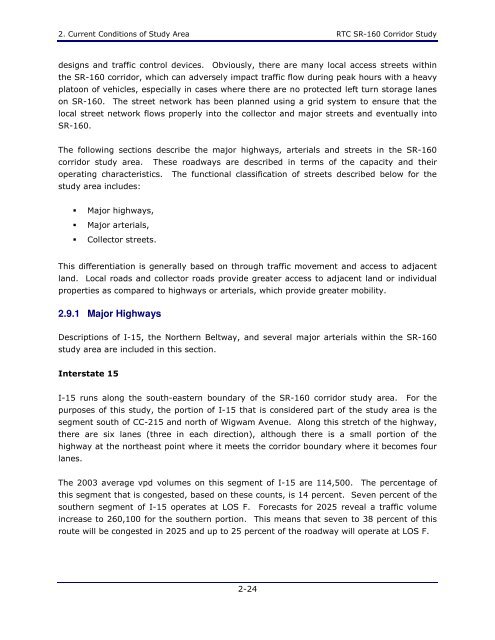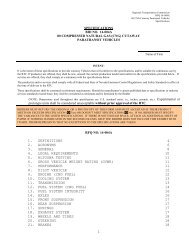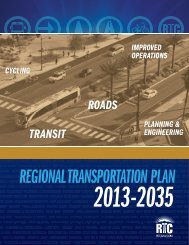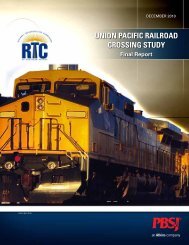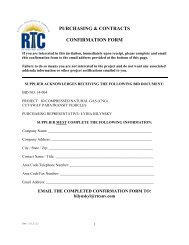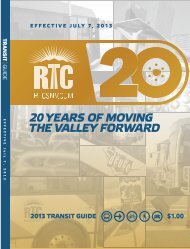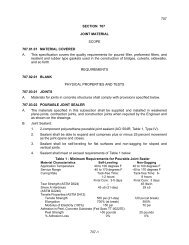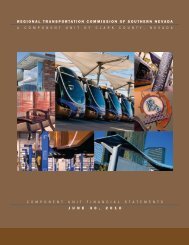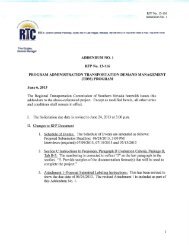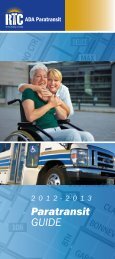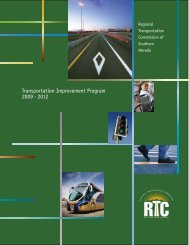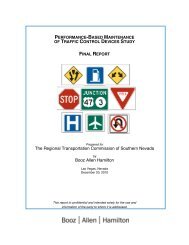(Blue Diamond Road) Corridor Study - Regional Transportation ...
(Blue Diamond Road) Corridor Study - Regional Transportation ...
(Blue Diamond Road) Corridor Study - Regional Transportation ...
You also want an ePaper? Increase the reach of your titles
YUMPU automatically turns print PDFs into web optimized ePapers that Google loves.
2. Current Conditions of <strong>Study</strong> Area RTC SR-160 <strong>Corridor</strong> <strong>Study</strong><br />
designs and traffic control devices. Obviously, there are many local access streets within<br />
the SR-160 corridor, which can adversely impact traffic flow during peak hours with a heavy<br />
platoon of vehicles, especially in cases where there are no protected left turn storage lanes<br />
on SR-160. The street network has been planned using a grid system to ensure that the<br />
local street network flows properly into the collector and major streets and eventually into<br />
SR-160.<br />
The following sections describe the major highways, arterials and streets in the SR-160<br />
corridor study area. These roadways are described in terms of the capacity and their<br />
operating characteristics. The functional classification of streets described below for the<br />
study area includes:<br />
<br />
<br />
<br />
Major highways,<br />
Major arterials,<br />
Collector streets.<br />
This differentiation is generally based on through traffic movement and access to adjacent<br />
land. Local roads and collector roads provide greater access to adjacent land or individual<br />
properties as compared to highways or arterials, which provide greater mobility.<br />
2.9.1 Major Highways<br />
Descriptions of I-15, the Northern Beltway, and several major arterials within the SR-160<br />
study area are included in this section.<br />
Interstate 15<br />
I-15 runs along the south-eastern boundary of the SR-160 corridor study area. For the<br />
purposes of this study, the portion of I-15 that is considered part of the study area is the<br />
segment south of CC-215 and north of Wigwam Avenue. Along this stretch of the highway,<br />
there are six lanes (three in each direction), although there is a small portion of the<br />
highway at the northeast point where it meets the corridor boundary where it becomes four<br />
lanes.<br />
The 2003 average vpd volumes on this segment of I-15 are 114,500. The percentage of<br />
this segment that is congested, based on these counts, is 14 percent. Seven percent of the<br />
southern segment of I-15 operates at LOS F. Forecasts for 2025 reveal a traffic volume<br />
increase to 260,100 for the southern portion. This means that seven to 38 percent of this<br />
route will be congested in 2025 and up to 25 percent of the roadway will operate at LOS F.<br />
2-24


